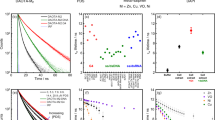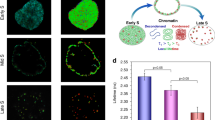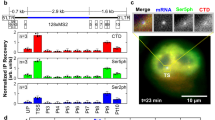Abstract
Substantial evidence now exists to support that formation of DNA G-quadruplexes (G4s) is coupled to altered gene expression. However, approaches that allow us to probe G4s in living cells without perturbing their folding dynamics are required to understand their biological roles in greater detail. Herein, we report a G4-specific fluorescent probe (SiR-PyPDS) that enables single-molecule and real-time detection of individual G4 structures in living cells. Live-cell single-molecule fluorescence imaging of G4s was carried out under conditions that use low concentrations of SiR-PyPDS (20 nM) to provide informative measurements representative of the population of G4s in living cells, without globally perturbing G4 formation and dynamics. Single-molecule fluorescence imaging and time-dependent chemical trapping of unfolded G4s in living cells reveal that G4s fluctuate between folded and unfolded states. We also demonstrate that G4 formation in live cells is cell-cycle-dependent and disrupted by chemical inhibition of transcription and replication. Our observations provide robust evidence in support of dynamic G4 formation in living cells.

This is a preview of subscription content, access via your institution
Access options
Access Nature and 54 other Nature Portfolio journals
Get Nature+, our best-value online-access subscription
$29.99 / 30 days
cancel any time
Subscribe to this journal
Receive 12 print issues and online access
$259.00 per year
only $21.58 per issue
Buy this article
- Purchase on Springer Link
- Instant access to full article PDF
Prices may be subject to local taxes which are calculated during checkout




Similar content being viewed by others
Data availability
All data generated during this study are included in this published Article and its Supplementary Information.
References
Sen, D. & Gilbert, W. Formation of parallel four-stranded complexes by guanine-rich motifs in DNA and its implications for meiosis. Nature 334, 364–366 (1988).
Hänsel-Hertsch, R., Di Antonio, M. & Balasubramanian, S. DNA G-quadruplexes in the human genome: detection, functions and therapeutic potential. Nat. Rev. Mol. Cell Biol. 18, 279–284 (2017).
Chambers et al. High-throughput sequencing of DNA G-quadruplex structures in the human genome. Nat. Biotechnol. 33, 877–881 (2015).
Schaffitzel, C. et al. In vitro generated antibodies specific for telomeric guanine-quadruplex DNA react with Stylonychia lemnae macronuclei. Proc. Natl Acad. Sci. USA 98, 8572–8577 (2001).
Biffi, G., Tannahill, D., McCafferty, J. & Balasubramanian, S. Quantitative visualization of DNA G-quadruplex structures in human cells. Nat. Chem. 3, 182–186 (2013).
Hänsel-Hertsch, R. et al. G-quadruplex structures mark human regulatory chromatin. Nat. Genet. 48, 1267–1272 (2016).
Chen, X. C. et al. Tracking the dynamic folding and unfolding of RNA G-quadruplexes in live cells. Angew. Chem. Int. Ed. 57, 4702–4706 (2018).
Laguerre, A. et al. Visualization of RNA G-quadruplexes in live cells. J. Am. Chem. Soc. 137, 8521–8525 (2015).
Zhang, S. et al. Real-time monitoring of DNA G-quadruplexes in living cells with a small-molecule fluorescent probe. Nucleic Acids Res. 46, 7522–7532 (2018).
Shivalingam, A. et al. The interactions between a small-molecule and G-quadruplexes are visualized by fluorescence lifetime imaging microscopy. Nat. Commun. 6, 8178 (2015).
Lukinavičius, G. et al. A near-infrared fluorophore for live-cell super-resolution microscopy of cellular proteins. Nat. Chem. 5, 132–139 (2013).
Rodriguez, R. et al. A novel small molecule that alters shelterin integrity and triggers a DNA-damage response at telomeres. J. Am. Chem. Soc. 130, 15758–15759 (2008).
De Cian, A., Delemos, E., Mergny, J. L., Teulade-Fichou, M. P. & Monchaud, D. Highly efficient G-quadruplex recognition by bisquinolinium compounds. J. Am. Chem. Soc. 129, 1856–1857 (2007).
Ying, L., Green, J. J., Li, H., Klenerman, D. & Balasubramanian, S. Studies on the structure and dynamics of the human telomeric G-quadruplex by single-molecule fluorescence resonance energy transfer. Proc. Natl Acad. Sci. USA 100, 14629–14634 (2003).
Tokunaga, M., Imamoto, N. & Sakata-Sogawa, K. Highly inclined thin illumination enables clear single-molecule imaging in cells. Nat. Methods 5, 159–161 (2008).
Etheridge, T. J. et al. Quantification of DNA-associated proteins inside eukaryotic cells using single-molecule localization microscopy. Nucleic Acids Res. 42, e146 (2014).
Guo, J. U. & Bartel, D. P. RNA G-quadruplexes are globally unfolded in eukaryotic cells and depleted in bacteria. Science 353, aaf537 (2016).
Rodriguez, R. et al. Small-molecule-induced DNA damage identifies alternative DNA structures in human genes. Nat. Chem. Biol. 8, 301–310 (2012).
Chandradoss, S. D. et al. Surface passivation for single-molecule protein studies. J. Vis. Exp. 86, 50549 (2014).
Tinevez, J.-Y. et al. TrackMate: an open and extensible platform for single-particle tracking. Methods 115, 80–90 (2017).
Ponjavic, A. et al. Single-molecule light-sheet imaging of suspended T cells. Biophys. J. 114, 2200–2211 (2018).
Ponjavic, A., Ye, Y., Laue, E., Lee, S. F. & Klenerman, D. Sensitive light-sheet microscopy in multiwell plates using an AFM cantilever. Biomed. Opt. Express 9, 5863–5880 (2018).
Chen, J. et al. Single-molecule dynamics of enhanceosome assembly in embryonic stem cells. Cell 156, 1274–1285 (2014).
Acknowledgements
This work was supported by programme grant funding from Cancer Research UK (C9681/A18618, to S.B.), core funding from Cancer Research UK (C14303/A17197, to S.B.), a Royal Society University Research Fellowship (UF120277, to S.F.L.), a Research Professorship (RP150066, D.K.), the EPSRC (EP/L027631/1, to D.K.) and a BBSRC David Phillips Fellowship (BB/R011605/1, to M.D.A.).
Author information
Authors and Affiliations
Contributions
M.D.A., A.P., D.K. and S.B. conceived and designed the experiments. M.D.A. performed the design, synthesis and biophysical characterization of G4 ligands. A.P. developed the microscope and protocols used for imaging. M.D.A., A.P. and R.T.R. performed in vitro imaging experiments. R.T.R. carried out surface preparation for in vitro experiments. M.D.A., A.R. and A.P. performed imaging experiments in cells. A.P. analysed imaging data. M.C., A.R. and X.Z. contributed to the synthesis and biophysical validation of the ligands. M.D.A., A.P., R.T.R., S.F.L., D.K. and S.B. contributed to the study design. J.S. assisted with DMS experiments. A.R. contributed to cellular staining and imaging. A.R. and L.-M.N. characterized the fluorescence properties of the G4 ligands. M.D.A., A.P., D.K. and S.B. interpreted the results and co-wrote the manuscript. All authors discussed the results and commented on the manuscript.
Corresponding authors
Ethics declarations
Competing interests
S.B. is a founder and shareholder of Cambridge Epigenetix Ltd.
Additional information
Publisher’s note Springer Nature remains neutral with regard to jurisdictional claims in published maps and institutional affiliations.
Extended data
Extended Data Fig. 2 Single-step photobleaching confirms detection of individual probes.
a, 25 pM SiR-PyPDS binding to MYC in vitro. The red square indicates a single binding event. b, Intensity traces from three binding events in (a), showing probes undergoing single-step photobleaching. The insets show time lapses for each molecule. Similar single-step photobleaching could be consistently observed in all single-molecule video acquisitions.
Extended Data Fig. 3 FRET between SiR-PyPDS and Alexa Fluor 488-labelled MYC confirms direct binding to G4s.
a, Emission spectrum of 488-MYC-G4 at 1µM and SiR-PyPDS at various stoichiometric ratios. As the probe concentration increases, donor emission drops and acceptor emission increases, indicating FRET. b, In vitro G4 FRET experiment. 250 pM of SiR-PyPDS (shown in red with acceptor excitation) interacting with Alexa Fluor 488-labelled MYC-G4 (with ~1% surface coverage). The green channel shows acceptor emission under donor excitation. FRET between MYC and SiR-PyPDS is highlighted with white arrows. c, 10 nM SiR-PyPDS interacting with 488-MYC-G4 (0.001% surface coverage). Temporal intensity traces of donor (green) and acceptor (red) emission under donor excitation. Anti-correlated intensity fluctuation upon acceptor photobleaching indicates single-molecule FRET between PyPDS and MYC. d, Example time lapse of acceptor (top, red) and donor (bottom, green) emission from (c). Experiments a-d were performed as 3 independent replicates all providing similar results.
Extended Data Fig. 4 Single-molecule imaging with SiR-PyPDS can be used to quantify MYC-G4 prevalence in vitro.
a, Number of detected binding events increases with probe concentrations. b, MYC fluorescence showing that the concentration of MYC on the surface can be controlled by mixing with a competing biotinylated oligomer. c, Number of detected events increases with G4 concentration. Sample images for each condition is shown beneath each plot. Error bars indicate mean ± sd. n=12 measurements taken from 2 independent replicates.
Extended Data Fig. 5 Induction of G4-folding by increasing concentrations of SiR-PyPDS measured with dually labelled FRET oligos.
a-c, Fluorescence emission spectra under Cy3 excitation for each G4 sequence. Experiments a-c were performed as 3 independent replicates all providing similar results.
Extended Data Fig. 6 The effect on SiR-PyPDS binding on unfolding kinetics of G4 DNA sequences in vitro.
G4 two-phase unfolding kinetics were measured by introducing 10 µM of respective complimentary DNA oligonucleotide at t=0 to trap the unfolded G4 oligonucleotide state. Data presented here are of best fit of a two-phase association model. Error indicates the standard error of the fit. n=1 measurement for each condition. Each experiment has been repeated 3 times providing consistent results.
Extended Data Fig. 7 Single-step photobleaching confirms detection of individual probes in cells.
a, 20 nM SiR-PyPDS binding to targets in a living cell. The red square indicates a single binding event. b, Intensity traces from three binding events in A, showing probes undergoing single-step photobleaching. The insets show time lapses for each molecule. Similar single-step photobleaching could be observed in all single-molecule video acquisitions.
Extended Data Fig. 8 SiR-PyPDS mainly accumulates in lysosomes.
Representative confocal and HILO microscopy images obtained in the presence of SiR-PyPDS (1 µM in confocal and 40 nM in HILO) and LysoTracker Green (50 nM), confirming co-localisation of extra-nuclear staining with lysosomes. Experiments have been repeated 3 times providing similar results.
Extended Data Fig. 9 Total nuclear accumulation of SiR-PyPDS and SiR-iPyPDS in U2OS cells.
Total fluorescence intensity measured inside the nuclei of >300 U2OS cells after incubation with 10μM SiR-PyPDS or SiR-iPyPDS by standard confocal microscopy at 633 nm. Each point on the graph represents the total fluorescence of SiR measured at 633 nm per nuclei, data are plotted as the mean of >300 nuclei measured in 3 independent replicates. Total fluorescence measurement revealed comparable ability of the two molecules to accumulate in the nuclei. Error bars indicate mean ± sd.
Extended Data Fig. 10 Cellular displacement experiments of SiR-PyPDS with the established G4-ligands PDS and PhenDC3.
Displacement of SiR-PyPDS in cells by competition with 10 µM of unlabelled G4-ligands PDS and PhenDC3. Cells were pre-incubated 30 minutes with PDS or PhenDC3 at 10 μM prior standard single-molecule imaging with SiR-PyPDS. Each point on the graph depicts the number of long-lived SiR-PyPDS event measured in independent replicates. Data are plotted as the mean of 3 or more independent replicates. Error bars indicate mean ± sd. * P < 0.05, two-sided Mann–Whitney U-test. n = 5,3 and 3 measurements taken from 3 independent replicates for no displacement, PDS displacement and PhenDC3 displacement respectively.
Supplementary information
Supplementary Information
Supplementary Methods and Figs. 1–5.
Supplementary Video 1
The fluorescent G4-ligand SiR-PyPDS specifically binds G4-MYC but not single-stranded DNA (mut). The control isomer SiR-iPyPDS shows significantly reduced binding to G4-MYC. Videos for final analysis have been collected from three or more independent replicates.
Supplementary Video 2
G4 binding by SiR-PyPDS can be inhibited by addition of 10 μM PhenDC3, demonstrating that observed binding events are G4 specific. Videos for final analysis have been collected from three or more independent replicates.
Supplementary Video 3
Long-lived binding events can be observed in living cells by SiR-PyPDS but not by the control isomer SiR-iPyPDS, suggesting that observed events are G4 specific. Videos for final analysis have been collected from three or more independent replicates.
Supplementary Video 4
When cells are treated with unlabelled PDS or PhenDC3, SiR-PyPDS ceases to bind to G4s in cells. White dashed circles indicate the nucleus. Videos for final analysis have been collected from three or more independent replicates.
Supplementary Video 5
Time-lapse imaging enables determination of the residence time of SiR-PyPDS binding to G4s. Videos for final analysis have been collected from three or more independent replicates.
Supplementary Video 6
When cells are treated with DMS, increased treatment durations result in a reduction in observed G4-binding events, as G4s become trapped in an unfolded state and can therefore no longer be bound by SiR-PyPDS. Videos for final analysis have been collected from three or more independent replicates.
Supplementary Video 7
G4 binding events can readily be observed during replication (S) and transcription (G1/S) cell cycle phases. In the quiescent state (G0/G1) minimal G4s can be observed. Minimal binding is also seen if replication and transcription are inhibited chemically (arrest). Videos for final analysis have been collected from three or more independent replicates.
Rights and permissions
About this article
Cite this article
Di Antonio, M., Ponjavic, A., Radzevičius, A. et al. Single-molecule visualization of DNA G-quadruplex formation in live cells. Nat. Chem. 12, 832–837 (2020). https://doi.org/10.1038/s41557-020-0506-4
Received:
Accepted:
Published:
Issue Date:
DOI: https://doi.org/10.1038/s41557-020-0506-4
This article is cited by
-
G-quadruplexes promote the motility in MAZ phase-separated condensates to activate CCND1 expression and contribute to hepatocarcinogenesis
Nature Communications (2024)
-
In vivo dynamics and regulation of DNA G-quadruplex structures in mammals
Cell & Bioscience (2023)
-
Telomeric retrotransposons show propensity to form G-quadruplexes in various eukaryotic species
Mobile DNA (2023)
-
Cerebral organoids with chromosome 21 trisomy secrete Alzheimer’s disease-related soluble aggregates detectable by single-molecule-fluorescence and super-resolution microscopy
Molecular Psychiatry (2023)
-
Chem-map profiles drug binding to chromatin in cells
Nature Biotechnology (2023)



